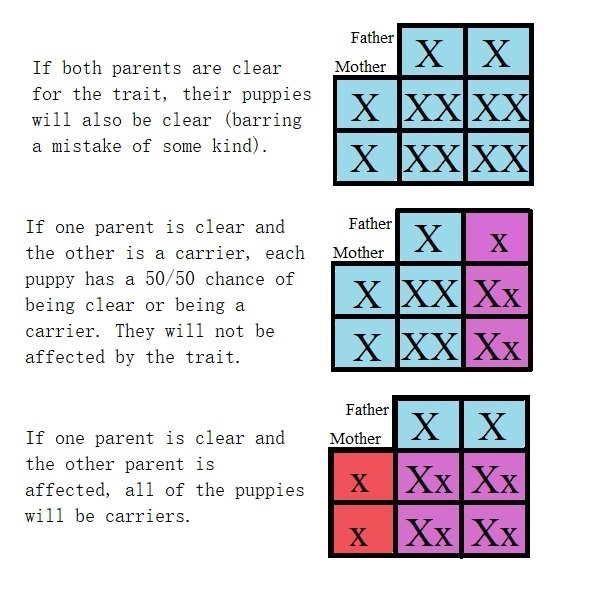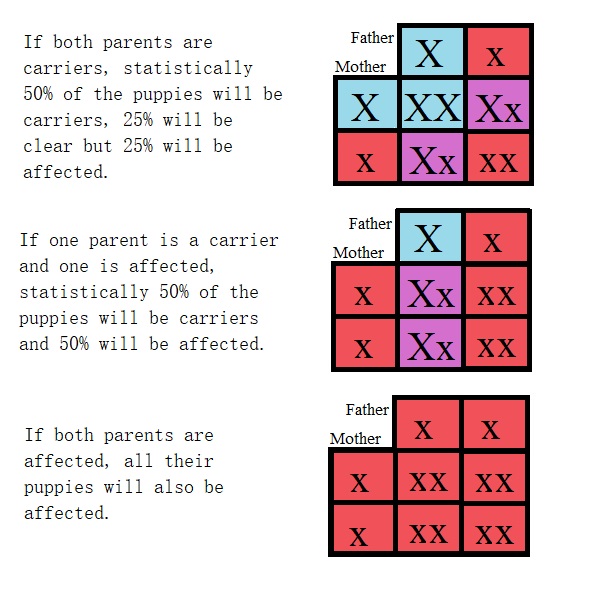
Genetic basics
Luckily Gregor Mendel tested his theories on the garden pea that has a relatively simple genetic structure.
He crossed yellow peas with green peas and tall plants with short plants to discover the fundamental laws of inheritance.
When he crossed yellow peas with green peas he often got only yellow peas.
But when he crossed the second generation together he got a few green peas mixed in with three times as many yellow peas. When he crossed green peas together, he got only green peas.
Mendel theorized that each parent contributed the "elementen" (one gene) for any given trait so the offspring had a pairing of those two genes.
But what you see on the outside doesn’t always tell you what's on the inside - the genetic makeup.
In today's terms, we would say the gene for yellow is dominant over the gene for green which is recessive.
When he crossed yellow with yellow and got only yellow, at least one of the parent plants was homozygous for yellow - meaning that parent plant carried only the yellow gene.
But when he crossed yellow to yellow and got some green peas, *both* of the parent plants carried the recessive green gene.
When he crossed green to green he could not get yellow because *neither* parent plant carried the yellow gene.
Genetic testing
Before breeding, the DNA strands carrying “... chromosome pairs are split apart and distributed into cells called gametes. Each gamete contains a single copy of every chromosome, and each chromosome contains one allele for every gene.”
Which variation of a gene winds up on which DNA strand and which strand from the father combines with which strand from the mother is due to chance which makes breeding so very interesting.
Genetic testing helps to make breeding decisions a little easier. Many genetic tests for our dogs are for a simple recessive gene, like yellow or green in the garden pea.
What this means is that there is one gene controlling the trait with two or more possible variations ("alleles") - a dominant allele and recessive alleles.
The recessive allele will only express itself if both parents contributed recessive alleles. When there is only one recessive allele the dominant allele it will ‘cover up' the recessive.
Terminology - English.OxfordDictionaries.com
- allele - one of two or more alternative forms of a gene that arise by mutation and are found at the same place on a chromosome
- dominant - relating to or denoting heritable characteristics which are controlled by genes that are expressed in offspring even when inherited from only one parent
- gene - a unit of heredity which is transferred from a parent to offspring and is held to determine some characteristic of the offspring
- heterozygous - having two different alleles of a particular gene or genes
- homozygous - having two identical alleles of a particular gene or genes
- recessive - relating to or denoting heritable characteristics controlled by genes that are expressed in offspring only when inherited from both parents, i.e., when not masked by a dominant characteristic inherited from one parent
Using genetic testing
If your puppy’s parents have been tested or if your puppy shows a genetic trait, such as yellow or chocolate color, you can make an educated guess about his genetic make up.
If he is yellow, then his parents are either yellow or carry yellow as a hidden gene. Both must carry at least one copy of the yellow gene.
If he is black, but has a yellow parent, then he carries one copy of the gene for yellow. It works the same for chocolate.
Yellow and chocolate are controlled by different genes so you can’t know if he carries the gene for the other color based on his color.
With one exception. Yellow Labradors usually have black noses and eye rims. When a yellow Lab has a chocolate nose and eye rims, he is homozygous for both chocolate and for yellow. Although it is a natural color in the breed, it is a disqualification in the show ring.
In a graph, the dominant trait (like black in Labradors) is capitalized and the recessive trait (chocolate) is lower-case:
BB = homozygous black in capital letters
Bb = heterozygous black in capital letters (hidden chocolate in lower case)
bb = homozygous chocolate in lower case
A yellow puppy with chocolate points, is shown as bbee with “e” meaning yellow. The dominant trait - “E” - means “not yellow.”
Early in the Labrador's history, yellow and chocolate puppies would appear occasionally. Because those colors were not popular, they were rarely bred (and sometimes not even allowed to live).
With no genetic testing available and limited knowledge of inheritance, breeders didn't know that those recessive colors hid in their dogs' genetics.
The recessive color could appear if the dog was bred to another dog who carried the same recessive color.
It is possible for a recessive gene to remain hidden for many generations. For example, Sandylands Mark, born in 1965, was black carrying chocolate despite 19 generations of blacks and yellows in his pedigree.
As a side note, because chocolate is a recessive gene saying a dog is "dominant chocolate" is incorrect. Chocolate is recessive to black and is a separate gene from yellow. So I think they mean "pure for chocolate" instead.
Click to learn more about Labrador coat colors.
For traits you can’t see, you should test the puppy unless both parents are clear for the trait.
EIC, CNM and PRA are also examples of simple recessives.
Here are some potential outcomes for a hypothetical trait where “X” is the dominant allele and “x” is the recessive allele. In the charts below, blue indicates the dominant allele. Red indicates the recessive allele. Purple indicates a mix of one dominant allele and one recessive allele.


These examples hold true for any trait that is a simple recessive.
Note: statistics only hold true with very large samples, except for breeding clear to clear or affected to affected where all puppies will be like their parents. However a carrier to carrier breeding could have all clear puppies or could have all affected puppies.


